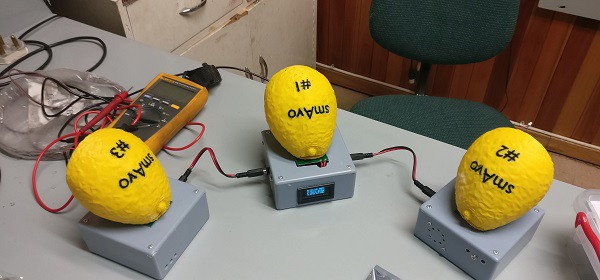In some packhouses, avocados fall as far as 300mm as they are tipped from the bin into the water bath at the start of the packline, a university research project has found, potentially diminishing the fruit’s quality and shelf life.
Prof Wynand Steyn, head of the civil engineering department at the University of Pretoria and PhD student André Broekman have designed a digital duplicate of an avocado, calling it a smAvo. It is 3D-printed from thermoplastic to closely resemble the texture and resistance of an avocado. They filled it with a number of sensors and instruments to track the bumpy ride of an avocado from the orchard to the carton.
 The research team has developed a number of smAvo prototypes, differing with regards to charging mode and waterproofing (photos supplied by André Broekman)
The research team has developed a number of smAvo prototypes, differing with regards to charging mode and waterproofing (photos supplied by André Broekman)
This is, as far as they know, the first time the risk of damage done to fruit on its way to the carton has been pinpointed, measured and evaluated. In the process they collect millions of data points to create a damage index for an avocado packhouse. This would have applicability to any damage-prone fruit and vegetables.
They have monitored the movement of avocados on the back of a trailer coming from the orchard, clearly showing the level of vibration among the fruit setting those in the top layers in free fall.
Yellow smAvos undertaking the journey from the orchard to the packhouse
They have sent four of these digital avos, called smAvos, across the packlines of dozens of avocado packhouses in Limpopo, Mpumalanga and KwaZulu-Natal to test the impact of acceleration forces and vibration on the fruit.
It goes through the same water bath, a point on the packline with high damage potential because the fruit accelerates as it hits the water and it oscillates in the water.
“At this stage no-one has quantified exactly where on the packline avocados pick up damage,” says André Broekman.
“For the moment we’re focusing on the packhouse but in the future we could track the journey all the way to Rotterdam. What effect does a storm at sea have? Did the avocados shift around? When the receiver notices quality problems, it will be possible to retrace the journey and identify exactly where and how the damage occurred.”
The pressure oranges exert on each other within a container is another example of a postharvest quality factor that would benefit from being studied in this way, he notes.
Tomatoes: reduced vibration means 3 more days of shelf life
In collaboration with major tomato producer ZZ2, they have similarly created a digital tomato (smaTo) to create a damage index for the packhouse and road transport, dependent on how the tomatoes are packed within a crate or carton but also potentially on factors like the air pressure in the truck’s tyres.
Blue smart tomatoes moving through the postharvest process, recording the forces working in upon the fruit
They have been able to precisely track which layers of tomatoes experience most vibration during road transport, and following from that how to pack tomatoes for the least amount of vibration.
“The more a fruit shakes, the worse for the fruit,” he says. “You can add three more days of shelf life to a tomato if it is delicately handled and optimally packed for the journey.”
“It’s a bit like opening Pandora’s box when you start looking at this – its application, especially on soft fruit like berries, strawberries, stonefruit is immense. In terms of postharvest handling it’s a low-hanging fruit to improve margins and reduce food wastage."
“This is real engineering,” he continues. “Civiltronics, a combination between transport engineering, electronics and programming. It’s an unbelievably exciting field and we’re writing the book on this.”
Hendus Janse van Rensburg and Frannes Joubert of ZZ2 with the digital fruit employed in a smAto packhouse trial
For more information:
Prof. Wynand Steyn
HoD Civil Engineering, University of Pretoria
Email: wynand.steyn@up.ac.za
André Broekman,
PhD Candidate (Civil Engineering)
Email: andre@broekmail.com
